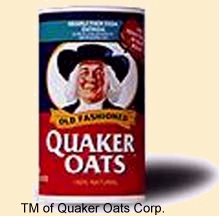How Oats are grown.
Oats were one of the first cereals cultivated by man. They were to be found growing in ancient China as long ago as 7000 BC while the Greeks are believed to be the first to make porridge from oats. However, it was the Romans who not only introduced oats to other countries in Western Europe, but also gave them and other cultivated crops the name cereals, after the Roman goddess of agriculture: Ceres.
Today there are many varieties of oats which have evolved from the original Asian wild grass (Avena Fatua). The best quality oats grow where there is light fertile soil, where the climate is temperate and there is a rainfall of over 60cm (24") a year.
Oat grains are sown in the winter and ripened in the fields by the summer sun. The oats are then harvested when fully ripe in the autumn. One can easily recognize oats from other grain crops such as wheat and barley, by the way the grains appear in clusters called "panicles" on tall graceful stems. A typical oat plant grows to around 90cm (3ft) high and each stem generally carries about twenty to twenty-five grains. Each panicle carries two or three grains and each grain is covered by a outer husk that helps protect it all the way to the mill.These oat grains are the raw material used to produce oatmeal and a variety of oat-based products.
Unique Milling Process.
Oats are taken into the mill at harvest time from a select registered panel of local growers. The oats are then dried and safely stored until needed. When the oats enter the Milling process, there are five distinct stages to this process:
1. Cleaning, drying and grading.
2. Dehulling and cleaning.
3. Groats to pinhead
4. Pinhead to oatlets.
5. Packaging and distribution.
1. The oats are brought at harvest into the mill by the growers. They are then cleaned and dried so that they may be safely stored until they are needed. When the oats enter the milling process, they are cleaned, taking off straws, stones and weed seeds and are then sent through a stream of air to remove any dust or light grains that would be unsuitable for milling.
2. The grain is then sorted by size into small grains, medium sized and large size grains. The Oats are then fed into the oat sheller, which cracks the husk off the grain without damaging the kernel. The mixture of kernel and hull is fed into a stream of air which blows off dust and hull. It is then subject to a polishing which removes the dust and hull which has not been properly dislodged.

3. The groats are then cut by feeding them into a cylinder with a large number of holes, the kernel fall through these holes and are cut to produce what is called Pinhead oatmeal. This is the oatmeal which can be used to make traditional porridge.
4. The pinheads are steam cooked at over 100 degrees celsius before being rolled into oatflakes. The flakes are then dried, cooled and stored in containers for packaging.
5. The product is then automatically weighed, dropped in its packet, the packet is then pressed down, folded and sealed. Flahavan's Progress Oatlets is packaged in 500g, 1kg, 1.5kg packs and also in 25kg bags. The packets are then packed into cartons ready for distribution to your local store.
Oats Process



